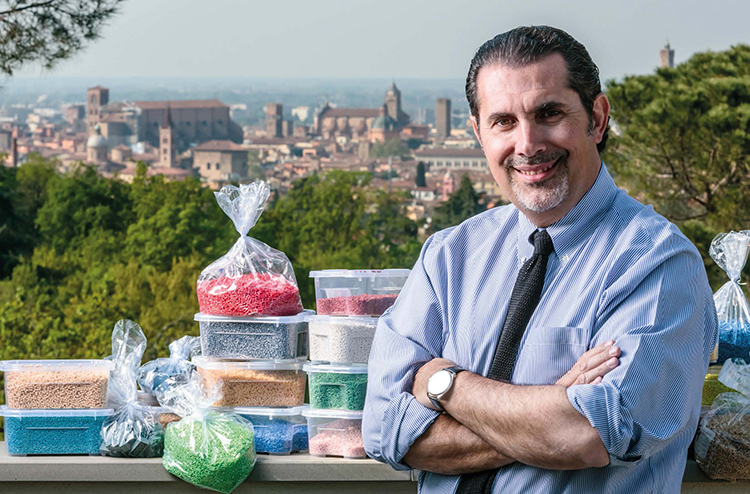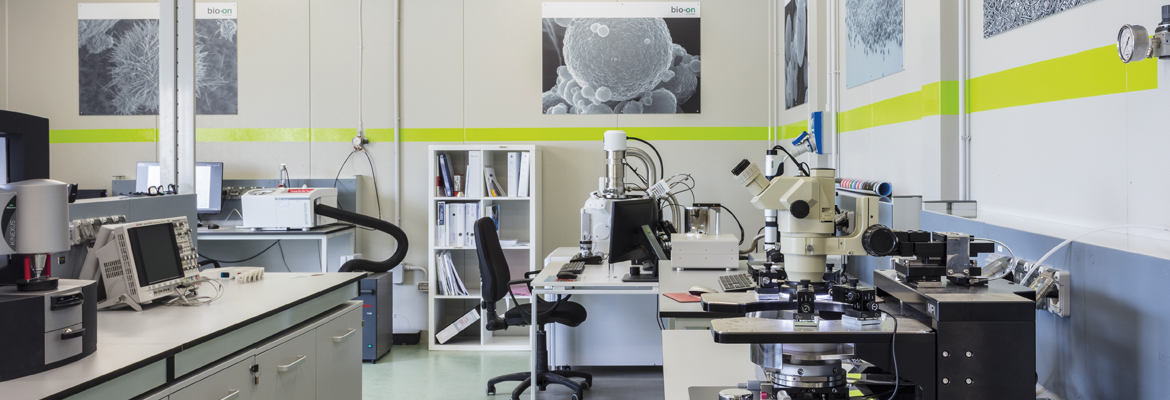
A new generation of high-performance biodegradable polyesters has arrived, made from sugar co-products or waste, derived from beetroot, potatoes, glycerol and extracts from fruit and vegetable waste. Bio-on, based in San Pietro Terme, halfway between Bologna and Imola, is pioneering this revolution. At its new €20 million plant, waste from agro-food businesses is transformed into completely natural polyester polymers. The final product is made of polyhydroxyalkanoates (PHAs), versatile materials that can be used in various sectors, from cosmetics to the biomedical industry.
But how are PHAs made? They are derived from “bacteria that has been man’s friend for millions of years, a material that can be consumed by other bacteria, because nature always finds a solution.” These are the words of Marco Astorri, president and CEO of Bio-on, who, in 2007, alongside founding associate Guy Cicognani, began this adventure in search of a 100% natural biopolymer. Their biggest strength? They have invested their profits in research, patents, certifications and publications.
How was Bio-on born?
“Our company started almost by accident. My associate Guy Cicognani and I, initially held a stake in a company that produced Radio Frequency Identification (RFID) equipment, which allows for contactless reading of tickets and cards, foregoing the use of magnetic strips. Then, one day, one of our clients came forward with an unusual request: they wanted tickets made of a compostable and hydrorepellent material that was not made from paper or plastic. At this point, I talked to Guy and we began to research biomaterials. With great surprise, we discovered a sector that was still in its infancy. Companies mostly produced polylactic acid (PLA), a polymer obtained from sugarcane fermentation that has identical characteristics to polyethylene, namely that it is indestructible and not very green. Therefore, we decided to sell our stake and invest the money in this new project. It was 2007, and we spent the first six months in front of our computers, studying and doing research.”
How did your research evolve?
“We are entrepreneurs and didn’t have a scientific background, so it was essential to deepen our knowledge. From our research into biopolymers made from corn-starch or PLA we gathered that companies producing green plastic had a number of problems. Firstly, their plastics didn’t perform as well as ones derived from oil; furthermore, they used enormous quantities of organic solvents for extraction, and they genetically modified the plants that they used. Basically, companies seen as environmentally friendly were actually not. Our objective was truly different: we wanted to find something that could revolutionise chemistry. And it was only by following this path that we were able to find what we were looking for: polyhydroxyalkanoate (PHA).”
Why PHAs?
“PHAs are completely natural linear polyesters. The product is synthesised within unmodified, non-pathogenic bacteria that ingest carbon and, over a 40-hour cycle, are able to produce an energy reserve: for them it’s like fat; for us it’s a linear polyester or plastic. This discovery was made in 1920, but it remained quiescent and was never developed further. It’s likely that the discovery happened in a historical period that impeded its application. Only after the war, with the advent of modern chemistry and Giulio Natta’s discovery of propylene, did we start to make plastic as it’s known today: carcinogenic, indestructible, environmentally damaging.”
Were there any similar projects already underway?
“In our research we had found studies from Japan, France and Portugal. And from Hawaii: here, the Islands’ university had registered five patents. Accompanied by our lawyer, we went to Honolulu to speak to Professor Jian Yu. This meeting was the real start of our adventure, as we purchased the entire set of patents, exhausting our financial resources. We found a solution to this quite quickly by turning to three major Italian sugar refineries and asking them to invest in our project. We secured their collaboration and started the company with an additional 3 million euros. Between 2008 and 2013 we managed to secure 10 more, which allowed for the implementation of the industrial plan. Soon we were able to respond to ever-growing demand.”
When was the real turning point?
“Probably in 2013, when we won a prize as the most innovative company. It was awarded to us in the UK, by TATA Group and the Financial Times. That was the first time we had a discussion about being listed on the stock market. Up to that point, we had a traditional business model, spending only net profits to avoid debt and protect our idea. It was then suggested that we go public, and after several years we can safely say we made the right decision. From that tentative 10% quote we recovered the first 9 million euros, allowing the company to grow further. In fact, between 2014 and now, our shares have risen in value from 5 to 60 euros each. As of the end of 2018 we have made deals with several important companies, such as TAIF JSC, one of the Russian Federation’s main industrial groups and a leader in the plastics sector, with whom we have a 17.6 million euro contract. Thanks to this agreement, the first PHA bioplastics production plant with Bio-on technology will be opened in the Republic of Tatarstan. Additionally, TAIF JSC Group will invest 90 million euros in the production region. Another example is Unilever, with whom we are about to launch a new line of sun-creams, MyKay, the first ever product that will substitute microplastics with our biopolymer.”
What features does the new plant here in Emilia have?
“Bio-on is based on the Intellectual Property Business Model (IPBM), and therefore on the granting of licences. This new plant was necessary to standardise high-performance applications that can then be sold as new requests are made. This is how we discovered other fields in which PHAs can be used, in their biopolymer powder form, such as cosmetics and professional 3D. This plant, producing 1,000 tonnes a year, costs over 20 million euros, and we are able to maintain high profitability through the IPBM.”
What kind of applications are you designing?
“We invest a lot in research, collaborating with approximately 20 universities all over the world. We are constantly experimenting with new applications. While at the beginning we just wanted to achieve something simple, to make cutlery or a biodegradable shopping bag; as experimentation continued we realised we had our hands on a platform product which could substitute a wide range of materials: expandable polyethylene (EPE), high-density polyethylene (HDPE), polyamides and many other plastics. If we had limited ourselves to the existing literature, we would have invested in PLA. And we wouldn’t be here now. The risk we took paid off, because PHAs have enormous potential. We started with smaller things, but now we’re undertaking large projects, like the cosmetics market. We also have biomedical applications, such as surgical mesh netting for hernias, and coronary stents. We believe in the protection and development of our patents. Our strength undoubtedly comes from being a CNS (Cosmetics, Nanomedicine and Smart Materials) centre, with 25 scientists in 350 square metres. In the new structure we will triple our workforce, because the PHA sector is still evolving and there is much left to explore.”
What advantages do PHAs have compared to polyethylene plastics?
“They are a biocompatible, biodegradable and non-hydrosoluble product. If they end up in the sea or in the ground, there will be bacteria able to biodegrade them as growth substrate. The good news is that plastic can be replaced.”
What are the organic parts used in the fermentation process?
“All the carbon sources, therefore all the sugars. There are very many waste products from the food production cycle that are not seen as worth preserving and would just be disposed of. The bacteria produce PHAs by eating these waste products. This means, incredibly, that it is possible to produce bioplastic quickly and efficiently anywhere in the world.”
Will it be possible to guarantee the exclusive use of agricultural waste, or will it be necessary to consume hectares of land to satisfy demand?
“Our company doesn’t use any land to create biopolymers. There are billions of tonnes of unused agricultural waste and they have to be the starting point. Our technology allows us to make use of something that would otherwise be thrown away.”



